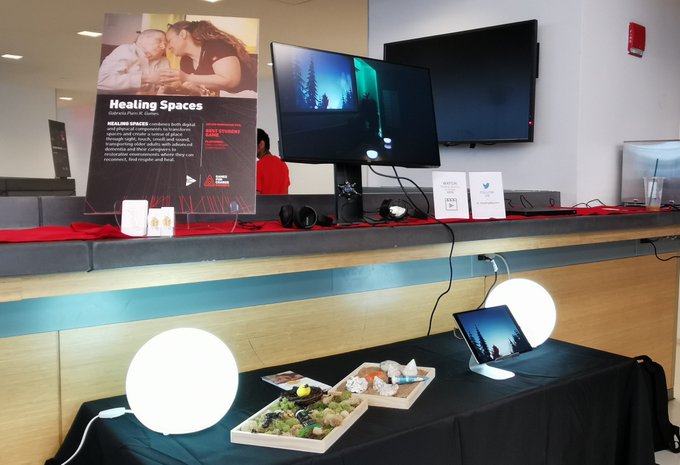In June 2019, the eSLUMS founder attended the Game for Change Festival at the Parson School of Design in New York City. During the conference, we were able to interview Gabi. She created HealingSpaces, a fascinating installation that includes both digital and physical components to transform spaces through sight, touch, smell and sound for older adults with advanced dementia.

Tell me about Healing Space, what type of experience is it and why are you motivated to create Healing Space?
It’s a multi-sensory in-door experience that allows elders with dementia to enjoy outdoor nature and relaxation. The multimodal experience comes with an iPad app with calming music and visuals images, ambient light delivered via a lamp that changes color, tangible manipulatives (e.g., seashells, sands), and hand creams with soothing scents to trigger memory reserve. There are two scene settings: forest and seaside (dawn and dust).
Why do you choose to design for patients with advanced dementia patients?
I designed this for my grandmother who passed away. I always want to design for people like her, who suffered from advanced dementia during her last days. I know she is still present even though she lost her ability to communicate and recognize us. I designed this for my grandmother who passed away. I always want to design for people like her, who suffered from advanced dementia during her last days. I know she is still present even though she lost her ability to communicate and recognize us.
What’s the design process and who’s on your team?
This was my master thesis project at the University of Southern California, and I collaborated with people from gerontology & occupational therapy, taking existing research on multi-sensory environment to make it accessible for people with dementia. My goal was to make this multi-sensory experience as easy to use as possible in both home and community settings, so it can help elders with dementia to reduce anxiety and increase engagement with the nature. Even though many advanced patients with dementia cannot communicate verbally, we are designing for that person who is still there.
How did you evaluate and implement your design?
So we did a small usability study in the LA community with about 8 residents. The facility has a dedicated sensory room in the facility. The usability testing is about 15-min, and during the study, we offer Healing Space to caregivers and let elders with dementia play with it to see what they do with it. We did not specifically measure any behavioral outcomes.
What are patients’ experiences using your installation? What type of feedback did you receive from the senior facilities, and staff members?
All of the patients at this facility are no longer able to give verbal feedback, so we mainly observed and interviewed caregivers (e.g., staff at the facility). The feedback I got has been really positive and encouraging, patients are really enjoying this multi-sensory experience and staff shared.
What do you plan to do with Healing Space now that you are moving to Europe?
Starting a company to bring this forward, realizing the needs for intervention, raise funding for future prototypes and research.
What are the challenges you experience when creating this experience?
Most of the challenges are related to funding and designing for constraints of real world implementations. How to scale up the product and packaging the digital and tangible products.
Can you give three advices to designers and clinicians who are interested in creating materials and activities for patients with dementia?
Spend time in the community observing professional caregivers interacting with people with dementia; remember that the person is still there, they may no longer be able to communicate verbally or perceive the world, it’s about finding the right tools and giving them the opportunities to connect in different ways.

Recent Comments